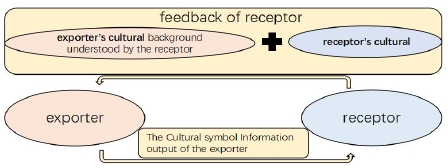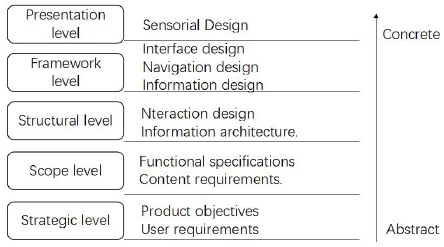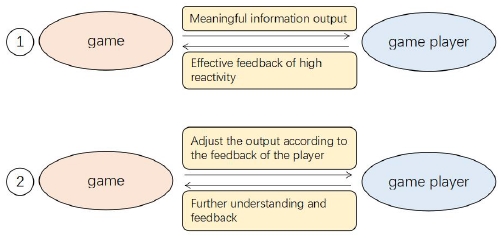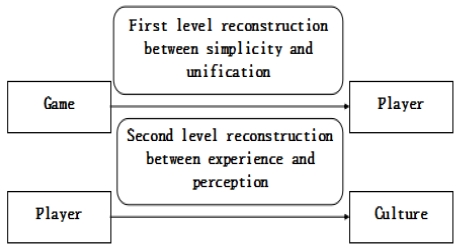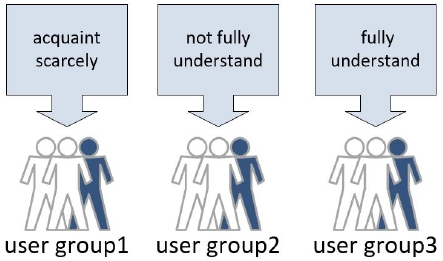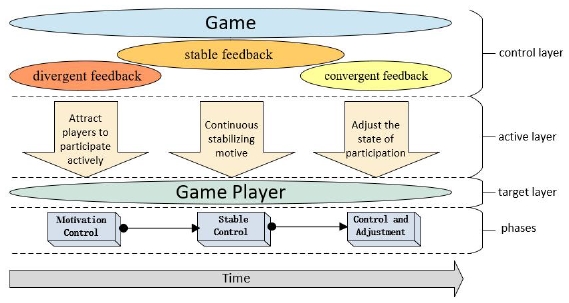
Exploratory Research on Game Cross-cultural Communication Theory Based on Control and Feedback
Copyright ⓒ 2019 The Digital Contents Society
This is an Open Access article distributed under the terms of the Creative Commons Attribution Non-CommercialLicense(http://creativecommons.org/licenses/by-nc/3.0/) which permits unrestricted non-commercial use, distribution, and reproduction in any medium, provided the original work is properly cited.

Abstract
This study discusses the cross-cultural communication function of digital games through the comparative analysis of cybernetic feedback mechanism and game feedback mechanism. In the communication process, there is a strong connection between information output, feedback and control. Effective use of relevant connections to improve the efficiency of information communication in the game process is the basic functional principle and logic of the game system to enhance cross-cultural communication. Compared with traditional communication media, game media has unique interactivity. This study will also explore the influence of game interaction mechanism on the extension of traditional control feedback theory.And as a further theoretical basis for the study of the cross-cultural communication function of games.
초록
본 연구에서는 사이버네틱 통제 메커니즘과 디지털 게임에서의 피드백 메커니즘의 비교분석을 통해 디지털게임의 문화간 소통 기능에 대해 탐구해 보고자 한다. 소통 과정에서 정보의 출력, 피드백, 제어는 매우 밀접하게 관련되어 있으며, 이를 효율적으로 활용하여 게임에서의 정보 전달의 효율을 향상 시키는 것은 게임 시스템이 글로벌 문화 소통을 강화하는 기본적인 원칙이자 논리이다. 기존의 미디어와 비교할 때 게임 매체는 독특한 소통성이 있다. 본 연구는 게임의 양방향 소통성이 기존의 통제 피드백 이론에 어떠한 영향을 끼쳤는지도 연구하여, 이를 게임이 가지고 있는 문화 전파 기능 연구의 이론적 기초로 삼고자 한다.
Keywords:
Digital game, Cultural perception, Cybernetics, Feedback, Cross-cultural Communication키워드:
디지털 게임, 문화 지각, 사이버네틱스, 피드백, 문화간 커뮤니케이션Ⅰ. Introduction
The electronic video game has been around for little more than half a century. The first recorded electronic game ‘Noughts & Crosses’ was developed in 1952 by A.S. Douglas, a scholar of computer science from the University of Cambridge. Compared with traditional media including books, newspapers, photography and film, the history of electronic gaming is still in its infancy. However, the electronic game is developing rapidly, far beyond the speed of traditional media.
As an emerging media, the electronic game has unique advantages not found in traditional media. Janet Murry discussed the aesthetics of the medium on the virtual environment of the game in Hamlet on the Holodeck: The Future of Narrative in Cyberspace. Murray’s virtual realistic aesthetic system consists of three components: immersion, agency and transformation [1]. Among them, Murry referred to the sensation of being surrounded by a completely other reality, "as different as water is from air, that takes over all of our attention, our whole perceptual apparatus" [1]. When people are placed in an exquisitely simulated space, they may have an immersive experience and tend to pay attention only to their perception in this new sensual environment. This characteristic of full immersion of auditory and visual senses and tactile interactions is not found in traditional media. The process that game players are immersed into through the way the immersive perceives the virtual environment and are completely substituted into final completion of a certain transformation requires another major feature of the game which is interaction.
Interactivity is the essence of human experience or awareness [2]. As one of the most salient characteristics of gaming arises from interaction, the game should become a powerfully perceived environment based on information interaction. Game players from different cultures can use the game to comprehend information, understand different cultures, and learn to communicate with each other. These characteristics reflects the pursuit of research on cross-cultural communication, which is to provide a flexible and adaptive interzone for people from different cultures to engage in effective communication [3]. It is the objective of the game industry to expand business for each country by enabling them to introduce their game works to the world. More importantly, it is also the strategic aim of international multiculturalism to facilitate cultural communication between countries.
Current research on cross-cultural communication functionality connected to gaming is incomplete. Related research is mostly confined to game study itself or the design of the game content and structure, with a lack of theory oriented structural framework. This paper investigates gaming as a new cross-cultural communication media and discusses the levels, cognitive states and differences between game user groups in game culture information perception. Through a basic analysis of symbolic cognition, the feedback relationship between two systems of the game and game player is quantified to some extent. In addition, through the analysis of game and control theory, this research attempts to explore the utility structure of gaming in cross-cultural communication on the basic principles of information communication and control. A feedback control structure of game cross-cultural communication is presented, based on control state. The foundation to this framework is the basic principle of control theory which is theoretically applicable to cross-cultural communication and other information interaction fields for various games. This research will lay a foundation to further enhance the cross-cultural communication functionality of game products.
Ⅱ. Dialectical View on Feedback Concept
Norbert Wiener introduced control theory in his 1984 treatise Cybernetics:
Or Control and Communication in the Animal and the Machine. Related concepts have subsequently developed. Rather than labelling control theory as a discipline, it is more accurate to say it is the scientific metaphysics of observing and understanding objects.
Claude Elwood Shannon enriched the interpretation and understanding of information by Wiener’s control theory through introducing information theory. This theory has been widely recognized by the academic community, however it is different from Shannon’s discrete viewpoint. In Wiener’s argument, the concept of information is continuous and therefore control theory can be understood as the theory of information communication and transmission [4]. evant knowledge of information theory must be relied on when discussing the role of control theory in communication. Generally speaking, the foundation of control is information. All information is transmitted for control, and the implementation of any control depends on information feedback. The entire process of control can only be accomplished through the accuracy and efficiency of communication. Any communication barriers in this process can affect whole systems or even destroy the stability of the entire control system.
Feedback information has different effects on whole systems (transmission process), resulting in feedback taking two forms: positive feedback and negative feedback. According to traditional control theory, the general definition of positive and negative feedback is centered around the difference between the current status of the system and the target, which is called target difference. Negative feedback leads to a decrease in target difference, while positive feedback increases the target difference [5]. The absolute definition used in the past states that the obstacles of communication, transmission and control are mainly reflected in positive and negative feedback of the information receptor. If the state of the transmission receptor itself is opposite to the target of output information control, for the stabilization and efficiency of the system itself (transmission process), it is necessary to increase negative feedback of the control target on the information and reduce positive feedback (Fig. 1).
The feedback concept of information is extremely important in control theory. As a form of universal metaphysics, system control theory exists in various disciplines and fields, and the meanings for positive and negative feedback can also vary. Some scholars have provided a new definition for positive and negative feedback based on the state of the system itself. If the feedback information maintains the system at a certain state, then this feedback is negative feedback. Conversely, if feedback information produces system instability and generates constant change, this is called positive feedback [6]. The utility of positive and negative feedback based on the system itself is relatively dialectical. The effect of positive and negative feedback on the target difference will not be absolute, and depends on the state of the system itself. This provides a method to re-recognize the cross-cultural communication mechanism of gaming from the perspective of control theory.
Ⅲ. Information and Feedback Analysis of Game Cross-cultural Communication
It must be clarified first that the ideal state of feedback action between the two systems of the game and the player is sustainable, stable and positive. Positive and negative feedback will also coexist within the interaction of the two systems. When game players engage continuously, the game system should also follow the corresponding principle (such as the condition for maintaining the player's specific state). The reactivity of game players should be enhanced as much as possible on the precondition of keeping the system stable. Therefore, the game must provide necessary information output to game players through various elements of its own to enable game players to generate corresponding feedback. To this end, game designers must carry out pre-structure design for the game based on possible feedback from the player. This means they must analyze the game and game player from the perspective of cultural symbol recognition and feedback.
Robert Wiener described the information receptor's state, writing “when I communicate with another person, I impart a message to him, and when he communicates back with me he returns a related message which contains information primarily accessible to him and not to me" [7]. When "I" and "another person" come from two different cultural concepts and symbolic systems, this difference is enough to cause entire communication activity to change, and cross-cultural communication is formed [3].
The receptor receives information and sends back information feedback of their understanding, a process that will be inevitably influenced by the information exporter’s information and the receptor’s cultural nature. From the perspective of cultural anthropology, the information sent out by the exporter automatically will contain the exporter’s cultural characteristics. As a human concept, values, actions, and even feelings, like human nervous system itself, are the products of culture [8]. From the perspective of cross-cultural communication, after the exporter transmits information with a certain cultural significance, the receiver can only give corresponding feedback under dual influence of the exporter’s cultural background and the background of their own receptor based on their understanding(Fig. 2).
The form in which the player receives game output information can be divided into two types, the audiovisual perception element and interactive perception. Among them, the audiovisual elements are dominant and mainly including character, prop, scene, color, text, sound effects, music, and other elements that can be directly seen and heard in the game. The easiest and often most efficient way to evoke the experience of culturally symbolic information from the receptor to the exporter is through vision and hearing. Humans are immersed in a world which they perceive through their sense organs [7]. While this is true in the natural world, it is intensified in the game, which provides an artificial world for the player. All things that exist in the game are elements that the player (input) uses to perceive the world. The player then further deepens their visual and auditory perception and learning experience in the game. More cultural symbols must be specifically implemented through the corresponding interaction perception designed in game infrastructure.
The levels of game design can be understood from the perspective of game design structure based on the previously discusses factors. Fullerton et al. have pointed out that a stable process is the key for a game to develop from conceptual idea to a successful work with satisfactory game experience [9]. Based on the four element game structure [10], current commercial game design includes a five level structure from conceptual function to specific manifestation. These are strategic level, scope level, structural level, framework level, and presentation level [11](Fig. 3).
As seen in Fig. 3, the objective of a game system is first determined at strategic level. Next, the objectives are implemented at scope level, structural level and framework level. After this, the designer sets up the interactive perception structure for the game and finally, these objectives are combined with audiovisual perception and are presented to a game player at the representation level. Taking the functional game of cross-cultural communication as an example, efficient cross-cultural communication is one objective of the game system. To achieve this objective, the game designers should consider how to maximize audiovisual perception by applying and combining interactive perception to ensure game players deliver effective feedback to the cultural information output when playing the game.
The game and game player are regarded as two different systems. After information output from the game system is transmitted to the game player, the player will output it again, which becomes the input of the game system. To a certain degree, the stability of this system is based on several output-input and input-output links. Each input and output operation is accompanied by corresponding feedback in this system. This feedback mechanism is put forward by Marian Mazur, with an organization similar to social control theory which is centered on humans. The same is true for the game, indirectly proving that control theory is an interdisciplinary metaphysic. Whatever the field is, control theory will always apply the same mathematical relationship to any process based on the feedback principle.
In a general theorem of social control, the series input-output actions of X and Y in the system are assumed to be X, the first action of system output is x1, and the first action of feedback output in the Y system is y1. When y1 returns to X system, the second feedback output of X system is x2, and the second feedback output of Y system that accepts x2 is y2(Fig. 4). Further input-output actions are carried out in the same manner. The ratio of input value to output value of two systems is the reactivity of the system [12].
Reactivity is a crucial factor for controlling systems. Based on the absolute value of the reactivity product, Mazur divided feedback into positive divergent feedback and negative divergent feedback that enhances the actions of all systems (where the absolute of the product is above 1). Mazur also categorized feedback as positive stable feedback, negative stable feedback (where the absolute value of the product is equal to 1), positive convergent feedback, and negative convergent feedback (where the absolute value is smaller than 1) [12]. If X system is the game and Y system is the game player, the relationship between the two is evident(Fig. 5).
Combined with Mazur’s categorizations, from the perspective of cross-cultural communication, the information feedback process consists of several feedback actions. The game player first receives, then perceives, experiences and learns signals and information (X1) from the game through interactive perception and audiovisual perception. Next, the game player sends feedback to the game (Y1) through an interactive mechanism. In this process, the game player produces meaningful feedback to the information, which is partially or fully understood, and perceives the information transmitted by the game and fed back to it. In response, the game adjusts the game player’s audiovisual, interactive and emotional experience based on their feedback and the precondition, without compromising the primary goal which is to output new information (X2) through interactive and audiovisual perception. The second information input, and subsequent interactive output operations ensure the game player receives superior information and learning experience(Fig. 6).
Throughout this process, the game system guides the user to generate clearer information cognition, more appropriate emotional fluctuation, and increasingly active participation in accordance with the various feedback needs of the players. This process is influenced by various audiovisual perceptions and interaction perceptions for improving the game's information control and communication effect [13].
After the game sends information to the game player, the player’s own sensitivity towards each element and perception reserve of cultural symbols and information determines how successful their initial perception of such information will be. Subsequently, the game player creates feedback through sufficient adequate cultural information provided by the game system. This includes the player’s external response in the game, and internal response related to their own information reserve. In this process, the cultural information in the game is sent to the player through the game and impliments the reconstruction and cognition of culture on the first level. As a result, the game player will awaken their experience and perception related to such information and following this, will further learn and comprehend such information based on their game experience. This process brings about second level reconstruction, where understanding is deepened and changes from the game player to the culture [14]. This process is described by Wiener who wrote, "Such a policy-feedback may, and often does, appear to be what we know under one aspect as a conditioned reflex, and under another as learning" [7](Fig. 7).
Conversely, this feedback can mean that the information is not perceived by game player successfully. After the player’s feedback is received by the exporter again, it is likely to jump out of the cultural framework of the exporter. Due to the barriers of information perception, the cultural information included by the game is likely to exceed the player's understanding of the culture. In such a case, the game player is thrust into an unfamiliar cultural environment, entering an entirely strange perception world [15]. In a strange environment, humans have to rely on their cultural understanding and experience, and the same is true within the game. Game players who fail to perceive information smoothly may experience misunderstanding and confusion about relevant information, which further affects the uncertain state of information communication. In this state, game players are forced to make subsequent feedback entirely based on their own understanding and cultural experience. The player’s reactivity is extremely low and even negative in this circumstance. The most common example of this is a situation where the gap between different languages will completely destroy the stability of system interaction between the game and player.
Apart from cross-cultural communication, the process also displays dialectical characteristics. When playing the game, players experience uncertain information perception, which is different from information uncertainty caused by random and contrasting games. The former lowers and even destroys the game experience, causing the game experience to end and eventually results in client loss. The latter can be regarded as an information entropy adjustment mechanism to actively adapt the information output of the game output player from a game information and interaction angle. It is necessary to appropriately adjust the strategy between the stabilization of the two systems in this situation.
In conclusion, the priority of game culture and other information communication lies in how to improve the amount of effective information and game player reactivity to the largest extent on the precondition of maintaining game interest. It is noteworthy that positive and negative feedback are not absolute for the game and game player as is mentioned in traditional understandings of this process. In fact, the player’s positive and negative feedback for game information may create positive results regarding the effect of game cross-cultural communication. This aspect is determined by the game player’s sensitivity towards information transmitted by the game, and their perception of information. Furthermore, it is related to the fact that the game is a changing interactive system centered on game players where players can receive information from the game and offer feedback. In the early stages of design, the game information output can be altered based on player feedback within certain rules and frameworks.
The game players exhibit three states after being exposed to cultural information output by the game, based on their own experience. First, players jump out of the exporter’s original cultural framework and offer feedback, relying on their cultural perception and cultural experience. Secondly, the game players have a certain experience of understanding the exporter’s cultural framework. Despite that, their perception is limited and requires more information to enrich and reconstruct their understanding of the objective culture through constant feedback. In the last state, the game players and the exporter share the same cultural framework. With adequate cultural experience and information perception, the game players will not have a huge sensitivity towards cultural information in the game, nor have much difficulty in perception reconstruction and learning.
As shown above User group 1 evolves into user group 2 through global market expansion and cross-cultural communication of game products, a continual process that is clearly more demanding when compared to user group 3. Such a functional shift for game cross-cultural communication should be based on the reactivity of the game players or Y system. From the perspective of the game designer, the game is the controller that gradually improves and stabilizes ry within the effective playing time and a certain range. It is important to take effective playing time and the stable state of ry into consideration.
3-1 Introduction to Effective Time
Effective time refers to the stable state between the game and game player. To achieve this objective, the game producer and the game itself must consider the functionality of cross-cultural communication and the business objective. This includes improvement in game sales, the volume of game players, and the constant attention paid to the game in that the game should encourage continuous play. To retain and enhance the player's basic motive to continuously play, the game system must attract their full devotion through quality game design. However, full devotion to any matter requires self-incentive, self-guidance, strong interest and real enthusiasm [16]. In this process, the game players may experience resounding emotions, which Mcgonigal refers to as fiergo [16], as well as a more familiar flow experience and other psychological and physiological states. As playing time lengthens, the players inevitably experience fatigue. Based on different game media, the game players may encounter physical fatigue, mental fatigue or a combination of the two [17]. In particular, mental fatigue occurs during long-term intense mental work, a lot of environmental stimuli, or the decline in behavioral activities caused by environmental atmosphere, stress, emotion, thought and burden. The typical consequences of mental fatigue, such as unwillingness or numbness, will greatly affect feedback stability between the game and game player [18]. Mental fatigue will lower the reactivity of the game player system and destroy stability between the game and game player as coupling between game and player systems gradually disappears when the players experience fatigue. In addition, feedback behavior will show a trend towards converging, and eventually stop. This stage is inevitable because of the restrictions in current game development technology, augmented reality technology and human physical and mental states.
3-2 Problems used in PBLIntroduction to ry State
Under normal circumstances, the game maintains the initial divergent positive-negative feedback structure by using step-by-step information output to slowly improve and maintain the reactivity of ry. However, fluctuations in information output, and diverse levels of feedback between the game and game player will cause rapid change to the stable structure of the two systems. For example, strong light stimulation may cause game players to experience physiological discomfort resulting in declining game motivation. This can be understood as the information output by X results in Y1 being unable to provide feedback to the stimulation. It is assumed that the output value of X1 is 1 and Y1 is 1, and if X2 suddenly outputs -1, the product of reactivity is -1. Severe light stimulation and rapid change in graphics may even result in extreme divergent feedback, including photosensitive epilepsy [19]. In such a case, the game player is unable to play the game normally so the relationship between X and Y has broken down. It is thus necessary to maintain the state of ry within certain stability based on the game player’s efficient and stable feedback behavior. In other words, the longer ry is stable, the longer game players play the game effectively based on their physiological and psychological tolerance.
Ⅳ. Feedback Control Phase and the Structure of Game Cross-cultural Communication
The guarantee of given time is one of the conditions for all information communication and interaction. Based on the comprehensive roles of various game elements, the game system creates abundant game experience to compel game players to lengthen their participation and maintain high reactivity, thereby laying a foundation for game communication behavior.
As mentioned above, the game process is a design strategy centered on the reactivity of the player. As their playing time increases, the playing state will change from relative active towards relative negative. All elements of the game are combined in this process and guide the game in control level through three feedback mechanisms, so as to further control the direction of game development. Additionally, these three mechanisms also correspond to certain functions in the three game stages, including attraction to game players, constant participation in the game, and experience adjustment(Fig. 9).
4-1 Motivation Control Phase
Mazur states that in feedback theorem of social control theory, the behaviors of two couple systems are consistent and in fact, the behaviors of two coupled systems are the same even if their reactivities are different [12]. This principle is represented in the direct reaction of the game initially attracting game players, and encouraging players to participate in game interaction. Such a reaction occurs through divergent and positive feedback. For example, when the game player receives visual and audio stimulation and is interested in an operation experience for the first time. As the player enjoys constant interactive feedback and the game, their feedback action is also enhanced. Most commercial games adopt positive stimulation of divergent positive feedback as the strategy to guide players to engage in active participation. In addition, features including bright images, skill effect, interesting game elements, and the game being easy to learn, give players the motivation to actively participate in the beginning, and imbed such motivation into the link of divergent positive and negative feedback. The application of divergent feedback strategies should ensure players take part in the game for longer time on the precondition of considering their toleration capacity. Once the actions between two systems exhibit large oscillations, the state of divergent feedback will change into the state of stable feedback. It is understood that when X1 is 1 and X2 suddenly increases to 100, the maximum feedback value of the Y system is 1. The product of system interaction reactivity in the first round of the system is largely vibration divergent positive feedback and the system interaction of the second round will transform into stable feedback. In the first stage where game players participate in the game, this interactive system takes attraction as its optimal objective. In this stage, all information output by the game must be aimed at attracting the player’s active participation in the game and attempting to maintain divergent positive-negative feedback between the systems. This stage is thus called the motivation control stage and aims to guide game players to exhibit active participatory behaviors. The leading objectives for the game, including functional and commercial performance, are not priorities in this stage.
4-2 Stable Control Phase
As the players engage in continuous participation in the game, the interactions between the two systems also actively shift from guidance to the stage of continuously stabilizing participation. Correspondingly, the game alters its feedback strategies at a control level. Single divergent feedback also gradually shifts towards coexistence of stable feedback and divergent feedback at this stage. During this process, the contents of basic games are mastered by game players. In addition, the original divergent feedback stimulation is learned and familiarized by game players, and it changes to a stable feedback state. For example, dazzling game skill will attract less attention from game players as this skill is used repeatedly. Eventually, the elements that cause game players to produce divergent feedback transform into stable feedback elements. Due to the role of motivation control in stage I, the transition in this stage is relatively active. If the motivation stage is regarded as a trial play version of the game, the stage of stable control is a complete part of the game.
As the divergent feedback state in stage I gradually changes into the state of stable feedback, the game requires new divergent feedback elements to balance the system, improve the player’s attention and lengthen playing time to maintain reactivity. In other words, the game not only outputs repeated behaviors and picture stimulations to game players, but also imbeds new game content to maintain and continue the coupling between the two systems. Along with access to new games, many commercial games provide increasingly richer game content and maintain the intensity of feedback actions between two systems through this mechanism. As playing time lengthens, the strength of divergent feedback becomes increasingly weak, which lengthens the cycle. This stage is known as the stable control stage. The stage of stable control tends to be the initiation of ensuring players participate in the game for a long time and have an excellent game experience. It is the most crucial stage, where game players are affected by game information the most. From the perspective of cross-cultural communication, this is also a core stage where game players learn and perceive cultural information and symbols through constant feedback learning.
4-3 Control and Adjustment Phase
Good control in the stable control stage ensures long-term system coupling between the game and player. Despite this, the relationship between the two systems will enter the third stage of adjustment control if the information output from the game and the player’s physical state are no longer capable of ensuring that the game players have adequate feedback strength in the stable control stage. In fact, the stage of control and adjustment is the time for producing convergent feedback between the game and game player. Due to several reasons, the convergent feedback state is inevitable. Although the game system does not adopt the strategy of lowering feedback strength actively, game players will also experience fatigue due to consistent feedback in the former two stages. From the perspective of the cross-cultural communication function of the game, this stage is crucial. Essentially, the cultural information perceived by the game experience requires adequate time to carry out reconstruction and learn internal knowledge through experienced cultural information. Michael H. Prosser has stated that "a stable, meaningful and clear-structured experience form leaves a memory and becomes our current perception…important perception experience is always originated from a culture" [20]. Therefore, relaxing and weakening feedback strength is also necessary for rest and this process may take place in the game or outside of it. Compared with divergent feedback and stable feedback, the action strength of convergent feedback is weak. The characteristic of declining and disappearing action strength in the game is represented in one typical case being the anti-addiction system set for under-aged players in some games. This also aims to end the coupling between the game and game player system smoothly to ensure the player’s physical and mental health.
It is understood that three control stages only correspond to one interactive cycle, and the system enters the next control stage automatically after each round of interaction ends. Combined with the player’s understanding of cross-cultural information mentioned above, the feedback control structure of cross-cultural communication for the entire game is presented in Fig. 10.
In any game development project, the game can complete one cross-cultural communication process by gradually lowering the player’s reactivity in three control stages. The change from user group 1 and user group 2, to user group 3 is an ideal state, however, in reality it is difficult to complete such a change completely. Conversely, the game player’s cultural information perception and reconstructed level bring about level advancement under effective control from cross-cultural communication information. It is important to note that adequate time is the precondition for achieving any development.
Ⅴ. Conclusions
This paper presents a feedback based cross-cultural communication framework for game players, which divides information interaction between the game and players into different control stages and cycles through divisions of feedback states. This framework provides high quality strategy design and effect guarantee for cross-cultural communication functions of the game. Using this structure serves as a direction and blueprint to develop complex games with cross-cultural communication functions.
In addition, the feedback based cross-cultural communication framework provides guidelines to control theory for developers outside of a common game industry, allowing game designers to introduce more fields into game design. Regarding cross-cultural communication functionality, this research aims at providing the possibility for functional game design centered on player feedback control. This information is applicable to developing game products with effective functionality that meet varying situations and objectives.
References
- J. H. Murry, Hamlet on the Holodeck: The Future of Narrative in Cyberspace, NewYork, The Free Press, p97-170, (1977).
- E. M. Kramer, Y. Liu Y, Intercultural Communication in the Context of Globalization, Beijing, Tsinghua University Press, p120-121, (2015).
- L. A. Samovar, R. E. Porter, and E. R. McDaniel, Communication between Cultures,6th Edition, Beijing, China Renmin University Press, p110p6-7, (2013).
- Z. X. Hu, Wiener and cybernetics, Encyclopedic knowledge, 6, p13-14, (1996).
- G. T. Jin, G. F. Hua, Cybernetics and scientific methodology, Beijing, popular science press, p23-32, (1983).
- Y. Y. Li, Positive feedback negative feedback concept, Social sciences research, 6, p57-58, (1988).
- N. Wiener, The Human Use Of Human Beings Cybernetics And Society, London, Free Association Books, p16, p12, p33, (1989).
- C. Geertz, The Interpretation of Culture, New York, Basic Books, Inc Publishers, p12, (1973).
- T. Fullerton, C. Swain C, and S. Hoffman, Game design workshop, a playcentric approach to creating innovative games, Burlington, Morgan Kaufmann Publications, (2008).
- J. Schell, The art of game design, Burlington, Morgan Kaufmann Publications, (2008).
- H. Ding, Z. He, G. L. Jing, and Q. Liu, Creationism - game system design guide, Beijing, Electronic Industry Press, p41, (2016).
- M. Mazur, Cybernetic theorems on feedback in social processes, In R.F. Geyer, and J. Van der Zouwen, (Eds.)Sociocybernetics Volume2, Leiden, Boston, London, Martinus Nijhoff Social Sciences Division, p29-39, (1978).
- T. C. Chen, T. Woo, Application, effect and value of the cultural transmission of game visual symbol in game character design, Journal of Korean Society of Media & Arts, 13(3), p73-92, (2017).
-
T. C. Chen, T. Woo, A Case Study on Cultural Sensibility and Communication Efficiency in Game---Civilization 6, Journal of Korean Society of Media & Arts, 15(5), p69-87, (2017).
[https://doi.org/10.14728/kcp.2017.15.05.069]

- D. Linell, Doing Culture: Cross-cultural Communication in Action, Beijing, Foreign Language Teaching and Research Press, (2001).
- J. Mcgonigal, Reality is Broken, Zhejiang, Zhejiang People Press, p34, p126, (2012).
- T. Z. Zhang, Several questions about the psychology of fatigue, Psychological Science, 3, p61-63, (1985).
- X. Liu, C. J. Wang, and Q. He, Characteristic analysis and prevention of traffic accidents by fatigue driving, Journal of Safety Science and Technology, 4(1), p128-131, (2008).
- X. Z. Xu, Computer games trigger two cases of epilepsy, Journal of hubei institute of science and technology (medical edition), 24(2), p173-173, (2010).
- M. H. Prosser, The Cultural Dialogue an Introduction to Intercultural Communication, Beijing, Peking University Press, p159-160, (2013).

2007년 : 포항공과대학교 전자계산학과 (학사, 석사) Tianjin University of Technology and Education(미학학사)
2014년 : 경희대학교 디지털콘텐츠학과(미학석사)
2012년~2014년: Digital designer of huanle.com
※관심분야: 디지털 게임, 다문화 전파, 기능성 게임

2002년 : University of Dundee (UK), Electronic Imaging. BA (Honours)
2004년 : University of Dundee (UK), Electronic Imaging. MSc (이학석사)
2010년 : University of Dundee (UK), Electronic Imaging (게임학), PhD(이학박사)
2004년~2007년: University of Dundee, Lecturer
2007년~2010년: KAIST 엔터테인먼트 공학연구소, 선임연구원 (기능성 게임렙)
2010년~2012년: KAIST 문화기술대학원, Digital Art & Entertainment Track 교수 (게임)
2012년~2013년: 서울대학교 융합기술대학원, 게임미디어랩교수
2012년~2013년: 서울대학교 차세대융합기술연구원, 게임융합미디어연구센터 센터장
z2014년~현 재: 경희대학교 디지털콘텐츠학과 교수
※관심분야: 기능성 게임,게임화, 게임문화, 차세대 게임

